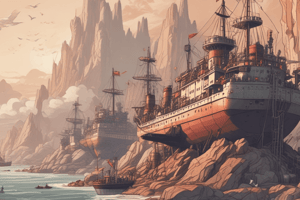Podcast
Questions and Answers
Explain the concept of economies of scale and provide two examples of factors that contribute to it.
Explain the concept of economies of scale and provide two examples of factors that contribute to it.
Economies of scale occur when the average cost of producing a good or service decreases as the quantity produced increases. This happens because fixed costs are spread over a greater output, leading to lower per-unit costs. Two factors that contribute to economies of scale are bulk purchasing discounts, where larger quantities of raw materials can be purchased at lower prices, and specialized equipment that is more efficient for large-scale production.
What are diseconomies of scale? Briefly describe two potential causes of diseconomies of scale within a company.
What are diseconomies of scale? Briefly describe two potential causes of diseconomies of scale within a company.
Diseconomies of scale occur when the average cost of production increases as the quantity produced increases. This is often due to issues such as communication problems, coordination difficulties, and managerial inefficiencies within a large organization. Two potential causes are poor communication within the organization, which can lead to delays and mistakes, and excessive bureaucracy, which can slow down decision-making and make the organization less agile.
Differentiate between capital-intensive production and labor-intensive production, giving an example of each.
Differentiate between capital-intensive production and labor-intensive production, giving an example of each.
Capital-intensive production relies heavily on machinery, technology, and automated processes, requiring significant investment upfront in capital equipment. An example is a car manufacturing plant with assembly lines and robots. Labor-intensive production employs a large number of workers relative to the amount of capital equipment. An example is a small tailoring shop where the majority of the work is done by skilled artisans.
What is revenue, and how is it calculated? Why is increasing revenue not always a sign of a successful business?
What is revenue, and how is it calculated? Why is increasing revenue not always a sign of a successful business?
Define profit and explain how it is calculated. What is a common goal for businesses in relation to profit?
Define profit and explain how it is calculated. What is a common goal for businesses in relation to profit?
What are fixed costs and variable costs? Provide an example of each in the context of a manufacturing company.
What are fixed costs and variable costs? Provide an example of each in the context of a manufacturing company.
Explain the concept of productivity. Why can higher productivity lead to lower costs and potentially greater profits?
Explain the concept of productivity. Why can higher productivity lead to lower costs and potentially greater profits?
Give an example of how a company might achieve economies of scale by specializing labor, and explain how this reduces average cost.
Give an example of how a company might achieve economies of scale by specializing labor, and explain how this reduces average cost.
Flashcards
Economies of Scale
Economies of Scale
Average cost per unit decreases as production increases due to spread of fixed costs.
Diseconomies of Scale
Diseconomies of Scale
Average cost rises as production increases due to inefficiencies in large organizations.
Capital-Intensive Production
Capital-Intensive Production
Production that relies heavily on machinery and technology rather than human labor.
Labor-Intensive Production
Labor-Intensive Production
Signup and view all the flashcards
Revenue
Revenue
Signup and view all the flashcards
Profit
Profit
Signup and view all the flashcards
Costs
Costs
Signup and view all the flashcards
Productivity
Productivity
Signup and view all the flashcards
Study Notes
Economies of Scale
- Economies of scale occur when the average cost of producing a good or service decreases as the quantity produced increases.
- This happens because fixed costs are spread over a greater output, leading to lower per-unit costs.
- Factors contributing to economies of scale include bulk purchasing discounts, specialized equipment, and managerial efficiency.
- Specialization of labor and machinery can also lead to greater efficiency.
Diseconomies of Scale
- Diseconomies of scale occur when the average cost of production increases as the quantity produced increases.
- This is often due to issues such as communication problems, coordination difficulties, and managerial inefficiencies within a large organization.
- Bureaucracy and excessive supervision can also hinder productivity, leading to higher average costs in larger firms.
- Coordination issues within large organizations, such as poor communication or slow decision-making processes, can cause inefficiencies.
Capital and Labour Intensive Production
- Capital-intensive production: Relies heavily on machinery, technology, and automated processes. It requires significant investment upfront in capital equipment, but often leads to higher output levels and greater efficiency in the long term, especially for large production runs.
- Labor-intensive production: Employs a large number of workers relative to the amount of capital equipment. Labor costs are a major component of the total production cost, making it more suitable for small-scale production or situations demanding high customer interaction.
Revenue, Profit, Costs, and Productivity
- Revenue: Total amount of money earned from selling a given quantity of goods or services. Calculated as Price x Quantity. Increasing revenue is generally a positive sign but doesn't automatically indicate profit.
- Profit: The difference between total revenue and total costs. Profit = Revenue - Costs. Profit maximization is a key goal for most businesses.
- Costs: The total expenses incurred in producing goods or services. Costs can be categorized as fixed (rent, insurance) or variable (raw materials, wages), and can further be differentiated between marginal, average, and total costs.
- Productivity: Measures the efficiency of production. The output of goods or services produced per unit of input, e.g., per worker, per hour, per unit of capital. Higher productivity generally leads to lower costs and potentially greater profits. Productivity is affected by factors including technology, labor skills, and management practices.
- Relationship Between Costs and Revenue: Profit cannot be achieved without sufficient revenue to cover costs. Businesses must manage costs effectively to maximize profit. Profit margin is the ratio of profit to revenue, often expressed as a percentage.
- Factors Affecting Costs and Productivity: Factors affecting costs include the price of raw materials, labor costs, overhead costs, technology choices, and economic conditions. Factors influencing productivity include worker training, technology improvements, efficient resource allocation, and management expertise.
Studying That Suits You
Use AI to generate personalized quizzes and flashcards to suit your learning preferences.




